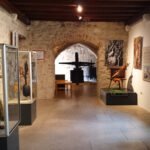Ethnographic Museum of Split
Located in a former residential complex in the southeastern quarter of Diocletian’s Palace, the Ethnographic Museum of Split is an interesting small-scale museum showcasing the local history through the historical objects of everyday life that were in use in Split and the surrounding areas in the past centuries. From the fantastic handmade lace interwoven by the nuns of Hvar, the historical costumes of many Dalmatian towns and villages to the fully and authentically furnished nineteenth century room.
Apart from works of ethnographic value, the museum’s peculiar location includes architectural features like the original archways of Diocletian’s private quarters, the courtyard and the house of medieval noble family Natalis (Božić), as well as the church of St Andrew de Fenestris (St Andrew of the ‘Windows’, thought to be one of the oldest surviving churches in town, whose location has been rediscovered at the location in the second half of the twentieth centuries.
A special feature of the Ethnographic Museum is its access to the roof of the grand vestibule of the Diocletian’s Palace, which offers an unique view of the bell tower of St Domnius, the Peristyle Square and the rooftops of the Old Town.











